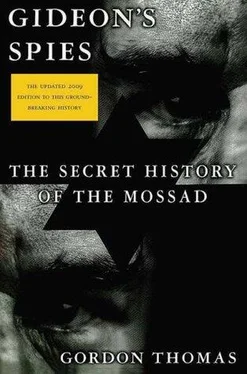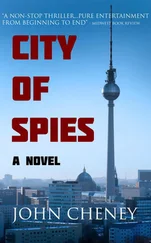Gordon Thomas - Gideon's Spies
Здесь есть возможность читать онлайн «Gordon Thomas - Gideon's Spies» весь текст электронной книги совершенно бесплатно (целиком полную версию без сокращений). В некоторых случаях можно слушать аудио, скачать через торрент в формате fb2 и присутствует краткое содержание. Город: New York, Год выпуска: 2009, ISBN: 2009, Издательство: Thomas Dunne Books, Жанр: История, на английском языке. Описание произведения, (предисловие) а так же отзывы посетителей доступны на портале библиотеки ЛибКат.
- Название:Gideon's Spies
- Автор:
- Издательство:Thomas Dunne Books
- Жанр:
- Год:2009
- Город:New York
- ISBN:978-0-312-53901-6
- Рейтинг книги:4 / 5. Голосов: 1
-
Избранное:Добавить в избранное
- Отзывы:
-
Ваша оценка:
- 80
- 1
- 2
- 3
- 4
- 5
Gideon's Spies: краткое содержание, описание и аннотация
Предлагаем к чтению аннотацию, описание, краткое содержание или предисловие (зависит от того, что написал сам автор книги «Gideon's Spies»). Если вы не нашли необходимую информацию о книге — напишите в комментариях, мы постараемся отыскать её.
Gideon’s Spies
Gideon's Spies — читать онлайн бесплатно полную книгу (весь текст) целиком
Ниже представлен текст книги, разбитый по страницам. Система сохранения места последней прочитанной страницы, позволяет с удобством читать онлайн бесплатно книгу «Gideon's Spies», без необходимости каждый раз заново искать на чём Вы остановились. Поставьте закладку, и сможете в любой момент перейти на страницу, на которой закончили чтение.
Интервал:
Закладка:
Only Dimona in the Negev Desert is surrounded by more secrecy. In the classified directory of the Israeli Defense Force, the Institute is only listed as “providing services to the defense Ministry.” Like Dimona, many of the Institute’s research and development laboratories are concealed deep underground. Housed there are the biochemists and genetic scientists with their bottled agents of death: toxins that can create crippling food poisoning and lead to death; the even more virulent Venezuelan equine encephalomyelitis and anthrax.
In other laboratories, reached through air locks, scientists work with a variety of nerve agents: choking agents, blood agents, blister agents. These include Tabun, virtually odorless and invisible when dispensed in aerosol or vapor form. Soman, the last of the Nazi nerve gases to be discovered, is also invisible in vapor form but has a slightly fruity odor. The range of blister agents include chlorine, phosgene, and diphosgene which smells of new-mown grass. The blood agents include those with a cyanide base. The blister agents are based upon those first used in World War I.
Outwardly featureless, with few windows in its dun-colored concrete walls, the Institute’s interior has state-of-the-art security. Code words and visual identification control access to each area. Guards patrol the corridors. Bombproof sliding doors can only be opened by swipe-cards whose codes are changed every day.
All employees undergo health checks every month. All have been subject to intense screening. Their families have also undergone similar checks.
Within the Institute is a special department that creates lethal toxin weapons for the use of Mossad to carry out its state-approved mandate to kill without trial the enemies of Israel. Over the years at least six workers at the plant have died but the cause of their deaths is protected by Israel’s strict military censorship.
The first crack in that security curtain has come from a former Mossad officer, Victor Ostrovsky. He claims that “we all knew that a prisoner brought to the Institute would never get out alive. PLO infiltrators were used as guinea pigs. They could make sure the weapons the scientists were developing worked properly and make them even more efficient.”
Israel has so far issued no denial of these allegations.
The start of the NATO spring offensive against Serbia in 1999 gave Halevy an opportunity for Mossad to provide an intelligence input to the nineteen countries that formed the Alliance. Mossad had long-established contacts in the region—out of real concern that the Balkans could eventually become a Muslim enclave, so providing a back door from which to launch terrorist attacks against Israel. It gave Halevy a welcome opportunity to visit NATO headquarters in Brussels and meet his counterparts. He traveled to Washington to see the CIA. Back home he worked a long day, often not taking a day off from one week to the next. In that respect he reminded people of Meir Amit.
In the spring of 1999, Mossad’s old bete noir, Victor Ostrovsky, surfaced to irritate the service. Carefully leaked reports from the team acting for two Libyans finally charged with the Lockerbie bombing said that Ostrovsky would give evidence for the defense. Given that the former katsa had left Mossad well before the incident, it was hard to see what he would have to contribute. Nevertheless, the sight of Ostrovsky in the witness box in the specially convened court in the Hague had, according to one senior Mossad source, deeply angered Halevy. He believed that an “understanding” had developed between Ostrovsky and his former employers that he would do nothing more to embarrass the agency in return for being allowed to live an unfettered life. For a while Halevy considered if there was any legal action he could take to stop Ostrovsky; in the end he was advised there was none.
In any event, by the time Ostrovsky appears in court, if he does, Halevy would have retired.
To achieve all he must do before he leaves the service would continue to be a huge test of Halevy’s physical and mental stamina. Aman and Shin Bet had seized upon the trouble in Mossad to boost their own position to be first among equals. Yet no one had suggested that Mossad should not retain its role as Israel’s secret eye on the world. Without its skills Israel might well find itself defeated by its enemies in the next century. Iran, Iraq, and Syria were all developing technology that needed to be closely monitored.
In the beginning, the operational style of Mossad had been to do what must be done, but do it secretly. In one of his one-to-one meetings with a staffer, Halevy had said he would like to see the Israeli intelligence community become a united family once more, “with Mossad the uncle no one talks about.”
Only time would tell whether that is an unsupportable dream or whether, as many observers fear, the further Mossad is from its last public humiliation, the closer it is to the next.
That came a step closer when, in June 1999, Mossad learned it could be asked to move its European headquarters in Holland following highly embarrassing claims that it has been secretly buying plutonium and other nuclear materials from the Russian Mafia. The allegation had been made by Intel, a small but formidable division of Dutch intelligence.
Intel’s investigation had been run out of a deep bunker—ironically built to shelter the Dutch Royal Family in the event of a Soviet nuclear attack on Amsterdam. The bunker is near the city’s Central Railway Station. Intel had established the terminus was journey’s end for some of the nuclear materials stolen from Russian weapons labs such as Chelyabinsk-70 in the Ural Mountains and Arzamas-16 in Nizhnii Novgorod, formerly Gorky.
Senior Mossad officers had insisted to Intel that precisely because the deadly materials were stolen, their agents purchased them from the Russian Mafia. It was the only way to stop the material being sold to Islamic and other terror groups.
While conceding that the Mossad claim was plausible, Intel investigators had become convinced that the nuclear materials had also been secretly shipped out of Amsterdam’s Schipol Airport to Israel to boost the country’s own nuclear weapons manufacturing plant at Dimona. Already stockpiled there were, by 1999, an estimated 200 nuclear weapons.
That Mossad had been trafficking with the Russian Mafia rekindled a nuclear nightmare that has never quite gone away. While the chilling Cold War doctrine of MAD—mutually assured destruction—had gone, in its place has come a more dangerous scenario where nuclear know-how and materials are on sale. It is capitalism, Wild East style, in which organized crime syndicates and corrupt government officials work in league to create new markets for nuclear materials—a bazaar with some of the world’s most dangerous weapons on offer.
Much of the work of tracing the origins of stolen nuclear material is done at the European Trans-Uranium Institute (ETUI) in Karlsruhe, Germany. There, scientists use state-of-the-art equipment to track whether stolen materials have come from a military or civilian source. But they concede “it’s like trying to catch a thief who has never been fingerprinted.”
To head off undoubtedly awkward questions should Mossad’s own fingerprints be found, Halevy made a secret visit to Holland in early June to explain to Intel Mossad’s role. Dutch intelligence remained unconvinced.
Halevy returned to Israel to tell its new prime minister, Ehud Barak, that Mossad should be prepared to move its European headquarters in the El Al complex at Schipol Airport.
Mossad had been based there for the past six years. From second-floor offices in the complex—known at Schipol as “Little Israel”—eighteen Mossad officers have run European operations. According to one Mossad source, Halevy’s position was clear: Better Mossad moves than be kicked out of Holland, a fate it suffered in Britain under the Thatcher government.
Читать дальшеИнтервал:
Закладка:
Похожие книги на «Gideon's Spies»
Представляем Вашему вниманию похожие книги на «Gideon's Spies» списком для выбора. Мы отобрали схожую по названию и смыслу литературу в надежде предоставить читателям больше вариантов отыскать новые, интересные, ещё непрочитанные произведения.
Обсуждение, отзывы о книге «Gideon's Spies» и просто собственные мнения читателей. Оставьте ваши комментарии, напишите, что Вы думаете о произведении, его смысле или главных героях. Укажите что конкретно понравилось, а что нет, и почему Вы так считаете.












